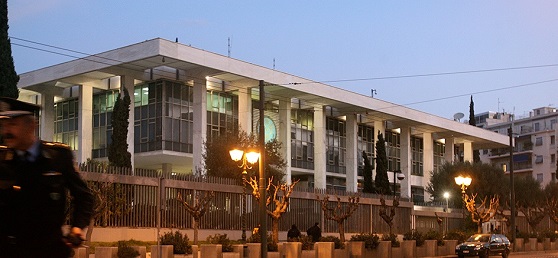
Modern architecture in Greece is endangered
 |
| Walter Gropius, American Embassy, Athens (1956-1961) |
Athens - Athens, world-renowned for its ancient monuments, can also boast neoclassical architecture from the 19th and 20th centuries. Its rare remnants are endangered due to the crisis and the fact that no one is striving to preserve them, writes the AFP agency.
Maria Daniilova was able to utilize subsidies and bank loans in the 1980s to restore her family’s three-story house built in 1936 in the Kukaki neighborhood near the Acropolis.
“Today, due to the crisis, it is expensive and difficult to repair this type of building. The government no longer provides support for this, so people abandon or demolish them,” states the architect, who specializes in buildings from the late 19th and early 20th centuries.
Her 300-square-meter house is built in a neoclassical and eclectic style using mixed techniques: the walls are made of stone and the floors of reinforced concrete. Like many other houses from this period, it has high ceilings, enclosed balconies, and murals above the entrance staircase.
According to the association Monumenta, which has created a database of data to encourage authorities and homeowners to preserve modern architecture, only 10,600 residential buildings in neoclassical or modern styles remain in Athens.
“Most of the houses are abandoned, deteriorating, or have been demolished. More than 80 percent of such houses have disappeared,” says Irini Gratsi, an architect specializing in heritage conservation and co-founder of Monumenta.
In the 1960s and 1970s, many of these buildings were demolished and replaced with reinforced concrete structures. This was a time when the metropolis was chaotically expanding. Five- to six-story buildings were constructed. It was also a way to revitalize the economy, which was in ruins after World War II.
The 1983 law on preserving neoclassical buildings was intended to encourage their owners to restore them, but the crisis, which has persisted since 2010, high taxation, and the absence of loans or government support have again led to their deterioration.
Two years ago, despite the efforts of Monumenta, a neoclassical house built in 1875 in one of the oldest neighborhoods in western Athens was demolished. This house was one of the few witnesses of Athens' first development in the 19th century, when the city had only 15,000 inhabitants. By the first half of the 20th century, Athens had half a million residents, and in recent decades, that number has risen to more than four million, states Irini Gratsi.
In the 1930s, the Bauhaus movement captivated wealthy Athenians with its functional aspect. Cube-shaped apartments no longer featured neoclassical decorative elements but met the needs of the then-middle class for comfortable living. They had central heating and elevators. The United States Embassy building, one of the beacons of modern architecture in Athens, was designed in the 1950s by German architect Walter Gropius, founder of the Bauhaus school.
Greek architects, students of the leading figure of 20th-century architecture Le Corbusier, also embarked on constructing apartments and public buildings in this style. “These buildings were gems of contemporary architecture, and those that remain must be preserved,” emphasizes Irini Gratsi.
Dimitris Joakim lives in a rented apartment in a building constructed in 1935 in the Bauhaus style. He complains that the repair costs are high and that the owner is reluctant to reimburse them. “Most of the owners of such houses have sold or rented them to immigrants,” he says.
The recent boom in Airbnb rentals has opened the way for the sale of these buildings to foreign investors. They renovate them to rent them out, mostly to tourists. “However, we need long-term solutions,” emphasizes Maria Daniilova.
The English translation is powered by AI tool. Switch to Czech to view the original text source.
0 comments
add comment






